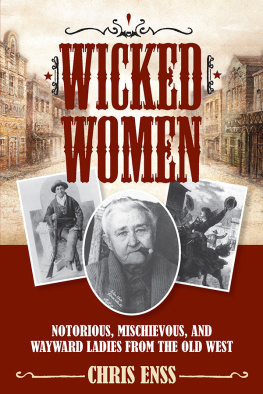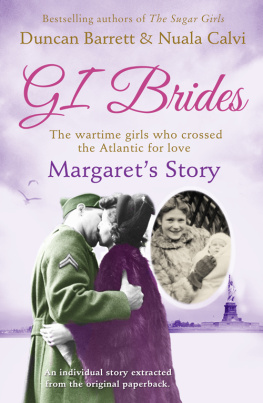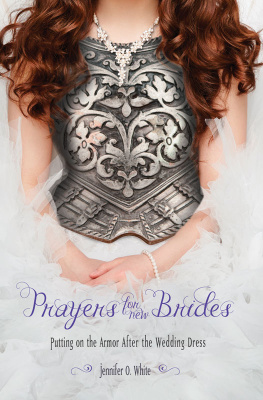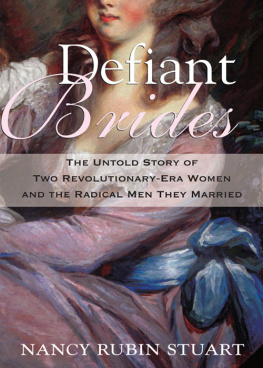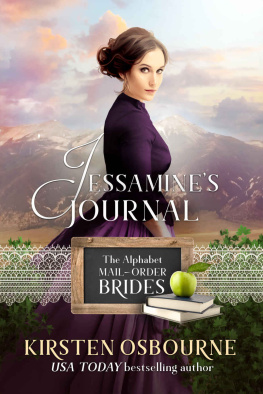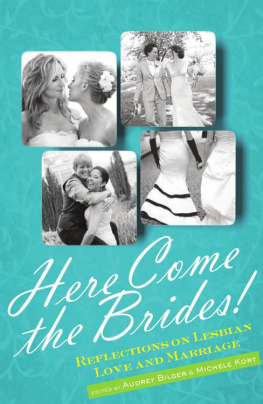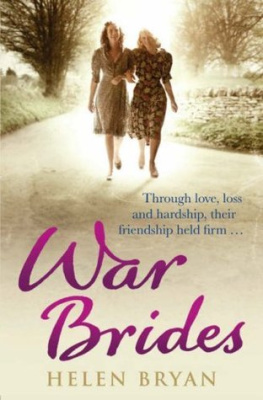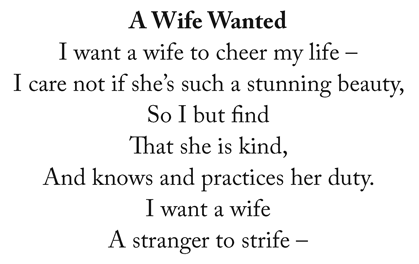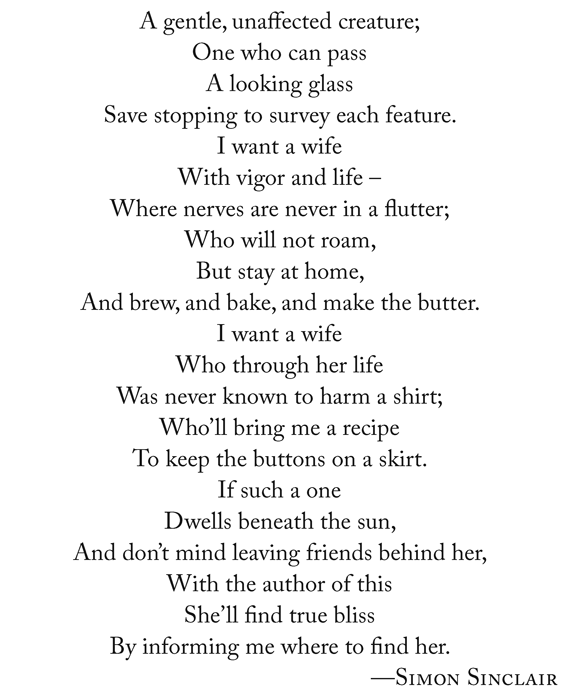ABOUT THE AUTHOR
Chris Enss has been writing about women of the Old West for more than a dozen years. She loves western culture and travels quite extensively, collecting research for her books. She received the Spirit of the West Alive award, cosponsored by the Wild West Gazette, celebrating her efforts to keep the spirit of the Old West alive for future generations. She currently lives in a historic gold-mining town in northern California.
ACKNOWLEDGMENTS
I have depended constantly upon the advice and encouragement of key individuals and organizations while working on this follow-up book to Hearts West: True Stories of Mail-Order Brides on the Frontier. Theres no way to adequately thank them, but Im going to try to do so.
I gratefully acknowledge the generous assistance of Barb Messer at the Madelyn Helling Library in Nevada City for handling the interlibrary loan transactions and for her vigilant effort to get the hard-to-locate material I needed. I wish to thank the librarys director, MaryAnn Trygg, for her kindness and sincere interest in whatever subject matter Im pursuing.
Special thanks are due to John Gonzales and Kathy Correia at the California Historical Library in Sacramento, California; Lori Devanaussi at the Steven H. Hart Library in Denver, Colorado; Fred Poyner at the Washington State Historical Society in Tacoma, Washington; Beverly Hackney at the Decatur Review newspaper in Decatur, Illinois; the researchers at the Kansas City Historical Society in Kansas City, Missouri; and the legal staff at Proctor & Gamble for supplying me with family history, letters, photographs, anecdotes, and articles.
I take great pleasure in acknowledging my obligation to Patti Ferree, Jeff Galpin, and the other talented members at House of Print and Copy in Grass Valley, California. Id be lost without them.
Cathy Reeves, Dodge City (Kansas) Public Library director, contributed greatly to completing this book, and I thank her for her enthusiasm and genuine love of authors.
I am indebted to my creative and hardworking editor, Erin Turner, and appreciative of the long relationship Ive had with Globe Pequot Press. I look forward to writing many more books for the publishing house.
Afterword
It is not good that man should be alone, the Lord said in the book of Genesis. No one knew that better than the lonely bachelors on the American frontier. It is with that in mind that brideswomen who wanted an honorable husbandwere imported. The absence of women in the Old West and marriageable men in the East led many to participate in unconventional ways to acquire a partner. The advertisements that were placed in mail-order bride publications, as well as the matrimonial agents that were hired between 1853 and 1890, brought many men and women together. Posts placed in newspapers such as the New Plan Company catalog and magazines such as Hand and Heart conveyed the longing of miners, trappers, and farmers for a spouse and expressed their promises to endeavor to be worthy of any women who accepted their hand in marriage.
A poem that appeared in the March 29, 1878, edition of the Hagerstown, Maryland newspaper the Hagerstown Mail, carried the sentiments of one such unattached man.
Marriage brokers, keenly aware of the money to be made matching eligible men and women, took full advantage of the situation. Fees for bringing couples together usually ranged from $70 to $400, although some brokers charged more.
Some particularly ambitious entrepreneurial types took matchmaking to a practically wholesale level. Asa Mercer, an entrepreneur residing in Seattle, Washington, organized a project for female immigration. For a $225 fee, Mercer promised suitable wives for men no longer wanting to be single. On January 16, 1866, a group of eligible maids and widows left New York under Mercers care aboard the SS Continental. The seven-thousand-mile voyage proved to be a success. Mercer fulfilled every contract with more or less satisfaction.
More than twenty years prior to Mercers trip, Eliza Farnham, an enterprising widow from New York, sought to recruit unencumbered females to join her matrimonial expedition west. She believed the gentling influence of a good woman could bring positive lasting changes for western pioneers and tame the wild frontier. Two hundred ladies responded to Elizas advertisement, but only a handful agreed to pay the $250 fee and accompany her to California. Upon arriving in San Francisco, Eliza met and married an entrepreneur named William Alexander Fitzpatrick.
According to the majority of ads placed in Matrimonial News, the countrys leading mail-order bride newspaper in the 1870s, men were searching for women who were musically inclined. They craved the comfort and entertainment value that music offered. Women, on the other hand, sought financial security over all else. They wanted a man who was solvent and could adequately provide for them and their future children. An advertisement addressing those qualities a man would find attractive and those a hopeful maiden needed in a husband, appeared in the fall 1877 edition of the Matrimonial News: Good, honest, respectable widow, strong and healthy, with business ability; age 48, weight 180, height 5 feet 11 inches, blue eyes, light brown hair, nationality French, Protestant religion, personal property worth $500, and also a musician; would marry a good honest man who is not afraid of work and would appreciate a good companion. Would like to hear from men of means.
Critics who objected to mail-order brides argued that such arrangements cheapened the sanctity of holy matrimony. Leaders of the Puritan church in Plymouth, Massachusetts, thought the practice would lead to the belief that marrying for love was less important than marrying for economic conditions. Politicians such as Horace Greeley and Protestant clergymen like Henry Ward Beecher believed mail-order brides were necessary given the ratio of women to men on the East Coast.
In January 1873, the Alton (IL) Evening Telegraph reported that there were between thirty and forty times more women in the city of New York than men. So long as war, commerce and the demands of the world for male labor exists to the extent in which they are now enjoyed in mining and railroading, the article noted, to the exclusion of females, women will be more numerous than ever.
BIBLIOGRAPHY
The Busy Bee Club
Brown, Dee. Wondrous Times on the Frontier. New York: Harper Collins Publishers, 1991.
Hine, Darlene Clark. Black Women in America: An Historical Encyclopedia. New York: Carlson Publishing, 1933.
Katz, William L. Black Women of the Old West. New York: Atheneum Books, 1995.
Miller, Brandon M. Buffalo Gals: Women of the Old West. New York: Lerner Publications Company, 1994.
Annie Stephens & Asa Mercer
Woods, L. Milton. Asa Shinn Mercer: Western Promoter & Newspaper. Norman, OK: The Arthur Clark Company, 2003.
Alton Evening Telegram (Alton, IL), September 27, 1921.
Daily Milwaukee News (Milwaukee, WI), January 26, 1866.
Independent Press Telegram (Long Beach, CA), June 12, 1952.
Logansport Daily Reporter (Logansport, IN), April 7, 2004.
Lowell Daily News (Lowell, IN), October 2, 1949.
The News-Post (Frederick, MD), April 9, 2004.


